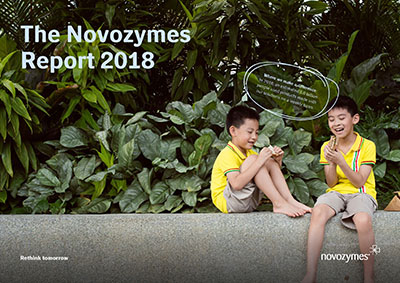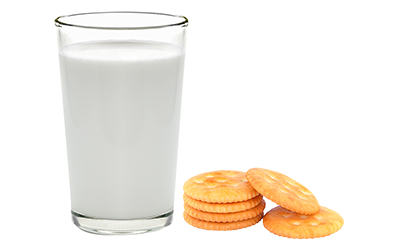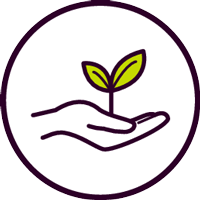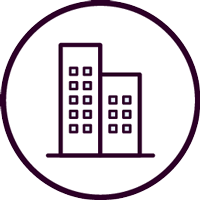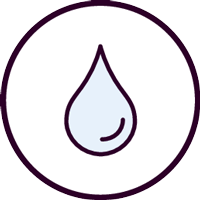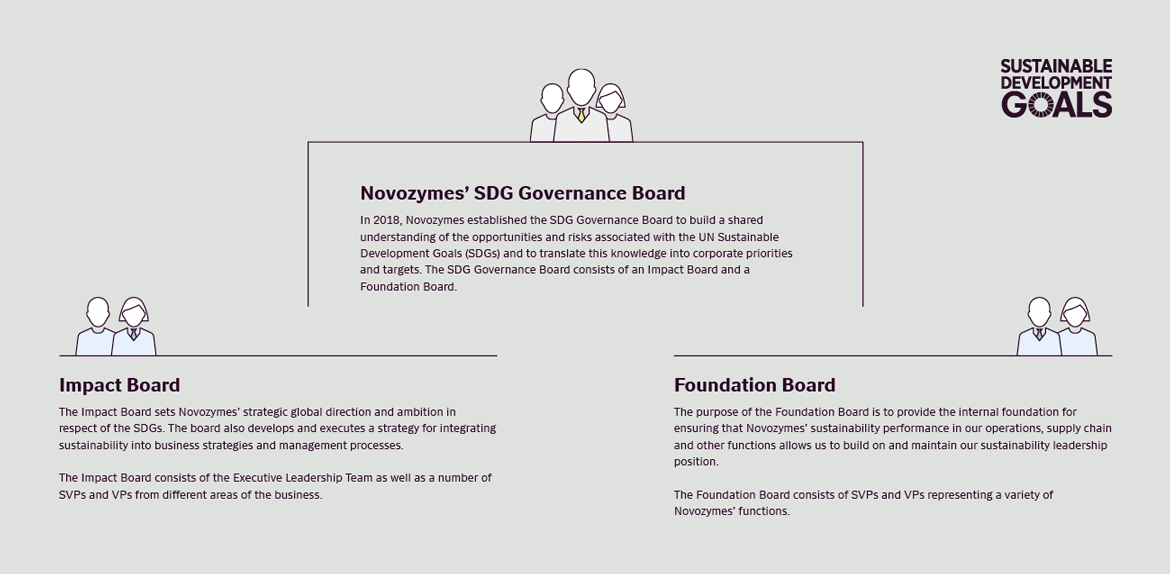Macrotrends that impact our business
Novozymes’ growth and long-term success are influenced by developments around the world that translate into global macrotrends. Some of these trends present potential opportunities while others present potential risks, all of which inform and shape our innovation and operational strategies.
Transition to sustainable agriculture
Description
A growing population, shifting consumer preferences and climate change-related supply chain disruptions
are putting increased pressure on global food supplies. At the same time, agriculture is in competition for land with other uses (e.g. urbanization). For these reasons, the agricultural sector is seeing growing demand for new and innovative sustainable food production solutions.
Our response to the trend
Many of Novozymes’ solutions are making a significant contribution to the transition to sustainable agriculture, and this remains a key focus area for innovation.
Example
Balancius™: A natural biological solution developed by Novozymes in partnership with DSM for improved
chicken gut health, reducing the amount of feed required to raise an animal by 3%.
Energy transition
Description
Rapid urbanization and a growing population are driving up demand for electricity, heat and transportation. The global movement toward a low-carbon economy and the fight against climate change are triggering a major shift in the global energy system. The cost of renewable energy is falling, and the world is increasingly exploring low-carbon alternatives to fossil fuels.
Our response to the trend
Novozymes’ response to the global energy transition is supported by our commitment to increase the share
of renewables in our energy mix as well as by our Bioenergy solutions, which address the need for low-carbon alternatives in the transportation sector, which is still heavily dependent on fossil fuels.
Example
below50: Novozymes is a founding member of this global campaign to reduce emissions in the
transportation sector by increasing demand for sustainable fuels.
Shifting demographics and urbanization
Description
The global economy is currently driven by three key demographic factors: rapid urbanization, a growing
middle class in emerging economies and an aging population in most developed economies. Patterns
of consumption are also becoming more varied and complex, particularly with the widening socioeconomic
gap. Consumer-based markets are looking for sustainable solutions that can keep pace with these shifts.
Our response to the trend
Novozymes is partnering with our customers to develop tailor-made solutions to address these changing
consumer needs effectively.
Example
Progress® In: Novozymes’ first product designed specifically for the broad market of unpenetrated
detergents and to help detergent producers in emerging markets develop better detergents.
Water scarcity
Description
Global demand for clean water is expected to outstrip supply by 2030, aggravated by climate change-related weather crises and severe pollution. Several regions of the world are experiencing severe water crises. Governments are responding with stricter regulation and surveillance of water management practices, which is driving demand for solutions that reduce water consumption, increase efficiencies and improve wastewater quality.
Our response to the trend
Novozymes is exploring the feasibility of using biotechnological solutions to address key challenges
within water and wastewater treatment. We already have a number of wastewater solutions in our portfolio, with more expected from our innovation pipeline.
Example
HelloScience: An open innovation platform, launched in partnership with UNICEF and pump manufacturer Grundfos, with the
purpose of finding new answers to some of the world’s most pressing water challenges.
Digitalization of the global economy
Description
Digitalization is transforming the world we live in – from the fabric of society to markets and businesses. This disruptive technology enables companies to adopt new ways of manufacturing, boosts production efficiencies and increases the agility and customization of their products and solutions.
Our response to the trend
Novozymes is focused on meeting customer needs better, faster and in a more impactful way through
industry-leading digital capabilities.
Example
DigiPro: A project that uses data analytics to improve yields, particularly from our fermentation and recovery processes – which are vital stages in the production of enzymes.
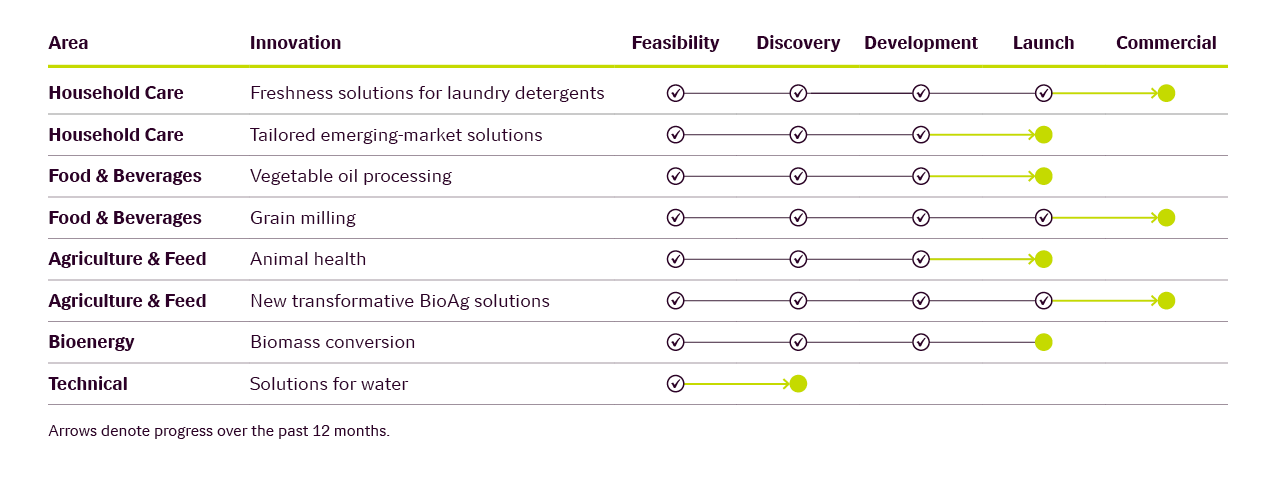
Novozymes’ innovation pipeline features more than 120 research projects across the business, with many more active leads. Our divisional structure is enabling us to bring new innovation to the market at a higher rate than ever, at the same time as leveraging significant cross-segment R&D synergies.
The table shows the eight priority innovation platforms, each with revenue potential of DKK 500 million or more. These areas represent significant market-expanding growth opportunities, most with the potential to impact the world in a sustainable way, enabling us to live up to our purpose of delivering biological answers for better lives in a growing world. In 2018, progress was made across most programs – three of which resulted in product launches.
Household Care
In Household Care, the first product from the freshness platform is now available on supermarket shelves in the Philippines as well as in other markets. Our freshness solution delivers completely new functionality, meaning that consumers can experience cleaner and fresher clothes. Available exclusively to one of our largest customers, this is only the first product to emerge from this platform. The overall potential of the freshness platform is expected to be in the region of DKK 1 billion, and we are already off to a very good start.
Food & Beverages
In Food & Beverages, we saw good development within the grain-milling program with the continued rollout of Frontia®, a solution enabling grain-milling processors to obtain significantly more starch and gluten during the grain fiber-milling process, yet with lower water and energy consumption. In vegetable oil processing, we ramped up our trialing activity for Palmora®, which improves yield and process performance in palm oil production by reducing viscosity and improving the separation of oil from the palm fruit pulp.
Agriculture & Feed
In Agriculture & Feed, both innovation platforms progressed according to plan. The animal health platform covers a broad portfolio of projects – including Balancius™ for improved chicken gut health, which we launched successfully together with DSM. The development with Bayer of new transformative microbes for corn, soybeans and wheat resulted in the launch of the Acceleron® B-360 ST (BioRise 2) corn inoculant.
Bioenergy
In Bioenergy, the market for second-generation ethanol has not developed as expected over the past years, but we remain positive about the future and the potential for Novozymes to contribute to a more sustainable world through second-generation ethanol. Our enzymatic technology for biomass conversion is ready to be commercialized as soon as the market for second-generation ethanol is ready.
Technical
In Technical, we were able to launch the first product from the water platform as early as in the fourth quarter of 2018, despite only adding “solutions for water” as a new innovation program in 2017. Our new enzyme technology enables wastewater plants to reduce the water content of their sludge – a by-product of wastewater cleaning. This helps plants to reduce chemical usage, energy consumption and overall disposal costs. This technology brings significant benefits to wastewater operators and to the environment. We are exploring the feasibility of biotechnological solutions that target key challenges within water and wastewater treatment, as we see the water treatment space as an exciting opportunity for Novozymes to leverage our core technologies to help address one of the world’s most pressing challenges.
Novozymes’ innovation pipeline features more than 120 research projects across the business, with many more active leads. Our divisional structure is enabling us to bring new innovation to the market at a higher rate than ever, at the same time as leveraging significant cross-segment R&D synergies.
The table shows the eight priority innovation platforms, each with revenue potential of DKK 500 million or more. These areas represent significant market-expanding growth opportunities, most with the potential to impact the world in a sustainable way, enabling us to live up to our purpose of delivering biological answers for better lives in a growing world.
In 2018, progress was made across most programs – three of which resulted in product launches.
In Household Care, the first product from the freshness platform is now available on supermarket shelves in the Philippines as well as in other markets. Our freshness solution delivers completely new functionality, meaning that consumers can experience cleaner and fresher clothes. Available exclusively to one of our largest customers, this is only the first product to emerge from this platform. The overall potential of the freshness platform is expected to be in the region of DKK 1 billion, and we are already off to a very good start.
In Food & Beverages, we saw good development within the grain-milling program with the continued rollout of Frontia®, a solution enabling grain-milling processors to obtain significantly more starchLong chains of sugar molecules. The main component of cereal grains such as corn, wheat and rice. and gluten
during the grain fiber-milling process, yet with lower water and energy consumption. In vegetable oil processing, we ramped up our trialing activity for Palmora®, which improves yield and process performance in palm oil production by reducing viscosity and improving the separation of oil from the palm fruit pulp.
In Agriculture & Feed, both innovation platforms progressed according to plan. The animal health platform covers a broad portfolio of projects – including Balancius™ for improved chicken gut health, which we launched
successfully together with DSM. The development with Bayer of new transformative microbesMicroscopic, living, single-celled organisms such as bacteria and fungi. for corn, soybeans and wheat resulted in the launch of the Acceleron® B-360 ST corn inoculantInoculants are beneficial microorganisms that promote plant health..
In Bioenergy, the market for second-generation ethanol has not developed as expected, but we remain positive about the future and the potential for Novozymes to contribute to a more sustainable world through second-generation ethanol. Our enzymatic technology for biomass conversionA method for turning agricultural residues and waste into high-quality fuels, electricity or renewable chemicals. is ready to be commercialized as soon as the market for second-generation ethanol is ready.
In Technical, we were able to launch the first product from the water platform as early as Q4 2018, despite only adding “solutions for water” as a new innovation program in 2017. Our new enzyme technology for sludge dewatering enables wastewater plants to reduce the water content of their sludge – a by-product of wastewater cleaning. This helps plants to reduce chemical usage, energy consumption and overall disposal costs. This technology brings significant benefits to wastewater operators and to the environment. We are exploring the feasibility of biotechnological solutions that target key challenges within water and wastewater treatment, as we see the water treatment space as an exciting opportunity for Novozymes to leverage our core technologies to help address one of the world’s most pressing challenges.

